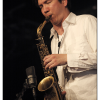Home » Jazz Articles » Album Review » Wadada Leo Smith's Great Lakes Quartet: The Chicago Symphonies
Wadada Leo Smith's Great Lakes Quartet: The Chicago Symphonies
Smith, who composed each of the movements, took his inspiration from Don Cherry 's Symphony for Improvisers (Blue Note, 1967) and expanded the creative content to include wider-ranging cultural aspects. Smith has effectively worn the mantle of activist/musician approach for some time, as heard on his Pulitzer Prize-nominated Ten Freedom Summers (Cuneiform Records, 2012), America's National Parks (Cuneiform Records, 2016), and Rosa Parks: Pure Love (TUM Records, 2019). Highlighting the exceptional contributions of Midwesterners to creative music is another of Smith's objectives on Chicago Symphonies. With the exception of Lindberg, the quartet are all long-standing members of the Association for the Advancement of Creative Musicians (AACM). Lindberg is a native Midwesterner, hailing from Michigan, now living in New York. Sections of movements pay tribute to Muhal Richard Abrams, Anthony Braxton, Leroy Jenkins, Sun Ra, and others with Chicago area affiliations. An additional nod to the region comes in the form of the final Sapphire Symphony where Smith pays tribute to two Illinois political legends, Abraham Lincoln and Barack Obama.
Gold Symphony—No. 1 consists of five movements in three segments. On "Movement 1," Smith's familiar parched tone and extended silences give way to a complex motif; Threadgill and the trumpeter play off each other while Lindberg and DeJohnette cut through to assume more prominent roles. "Movement 2" allows for solo time with DeJohnette accompanying each of his bandmates. A contemplative respite follows before a mélange of styles pays tribute to Louis Armstrong, Baby Dodds, Lil Hardin Armstrong, and Earl Hines.
Diamond Symphony—No. 2 with a tranquil Threadgill flute introduction, is quickly overtaken with multifaceted rhythms and rapidly changing patterns. DeJohnette drives the action on this disc, like maneuvering a train through roller coaster drops and slow turns. A frenetic pace dominates the first movement of Pearl Symphony—No. 3 but the section winds down with a glacially paced Threadgill bass flute. The idyllic "Movement 2" reflects Smith's affinity for the classics. Threadgill is a noticeable absence on Sapphire Symphony—No. 4. Much of the stately "Movement 1" is given over to DeJohnette and Smith, but by "Movement 2," Haffner's rounded saxophone sound and Smith's piercing trumpet create a harsh scuffle in the drift of the music. In the final "Movement 5"—the second dedicated to former President Obama—Smith's playing is majestic and soaring.
The Chicago Symphonies were written with a larger ensemble in mind. To that end, Smith can maximize and minimize within the confines of movements. As he approaches his eightieth birthday, Smith remains a remarkable figure in contemporary music, building on the rituals of avant-garde, classical, and jazz music. Figures that descend from different genres sweep in and bow out of the picture in continually fluctuating patterns. There are occasions when The Chicago Symphonies run out of steam but across nearly three hours of music, they are relatively few.
Track Listing
Disc 1: Movement 1: Light Fields and Circles: Amina Claudine Myers; Voices. Movement 2: Joyful, Sound and the Numbers; People: The Art Ensemble of Chicago: Movement 3: Pastoral: Joseph Jarman, As If It Were the Season of Seasons; Sherry Scott, Voice; Thurman Baker, Charlie Clark and Christopher Giddy. Movement 4: Creative Music; West End Blues and the Sonic Wealth Bird: Louis Armstrong, Earl Hines, Lil Hardin and Baby Dodds. Movement 5: Star-Fields: The Secretary, John S. Jackson. Disc 2: Movement 1: The Rare Air Songs In Sonic Forms and Metrical Folding: Henry Threadgill, Steve McCall and Fred Hopkins. Movement 2: Chicago: Culture, Creativity and the Artistic Passion; A Profile of the Next Generations. Movement 3: Muhal Richard Abrams: Levels and Degrees of the Light Spectrums; A New Culture: The Association for the Advancement of Creative Musicians. Movement 4: Jack DeJohnette: A Special Edition, New Directions and the Sonic Rhythm Units. Disc 3: Movement 1: For Alto; In the Orchestra: nJM 488; Anthony Braxton: Operas. Movement 2: Leroy Jenkins Mixed Quintet Sonics: Dance Opera. Movement 3: Heliocentric Sun Ra Energy and Particles of Light. Movement 4: Jupiter Skies: Kelan Phil Cochran and the Chicago Kulture. Movement 5: Scented Yellow and Red Chrysanthemums; Wadada Leo Smith: The Bell In Silence Resonants and Ten Freedom Summers. Disc 4: Movement 1: Abraham Lincoln, the 16th President of the United States of America. Movement 2: Abraham Lincoln at Gettysburg: Two Seven Two, 1863. Movement 3: The Visionaries, Abraham Lincoln and Barack Hussein Obama. Movement 4. Barack Hussein Obama at Selma: the Bridge of Transformation. Movement 5: Barack Hussein Obama, the 44th President of the United States of America.
Personnel
Wadada Leo Smith
trumpetHenry Threadgill
woodwindsJohn Lindberg
bassJack DeJohnette
drumsJonathon Haffner
saxophoneAlbum information
Title: The Chicago Symphonies | Year Released: 2021 | Record Label: TUM Records
< Previous
Canaries In A Musical Mineshaft
Next >
Glimpses of Truth
Comments
About Wadada Leo Smith
Instrument: Trumpet
Related Articles | Concerts | Albums | Photos | Similar ToTags
For the Love of Jazz
 All About Jazz has been a pillar of jazz since 1995, championing it as an art form and, more importantly, supporting the musicians who create it. Our enduring commitment has made "AAJ" one of the most culturally important websites of its kind, read by hundreds of thousands of fans, musicians and industry figures every month.
All About Jazz has been a pillar of jazz since 1995, championing it as an art form and, more importantly, supporting the musicians who create it. Our enduring commitment has made "AAJ" one of the most culturally important websites of its kind, read by hundreds of thousands of fans, musicians and industry figures every month.
























